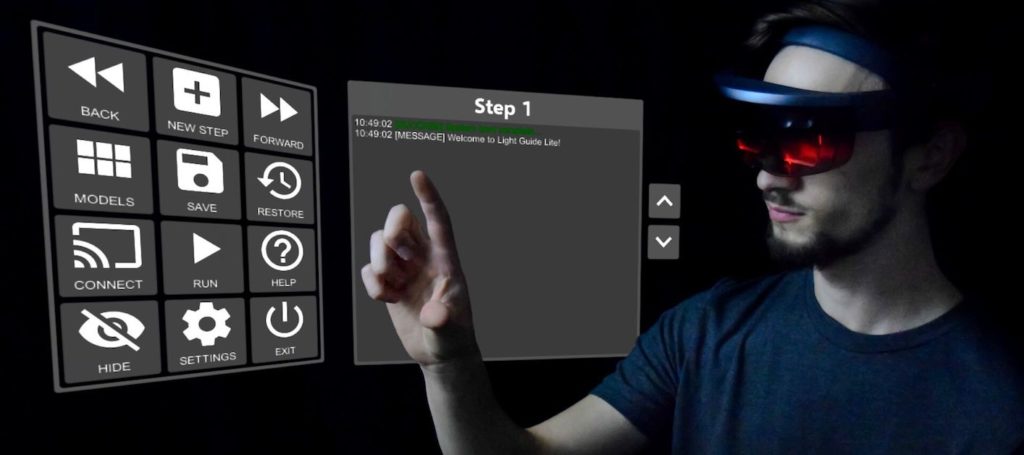
In today’s rapidly evolving Industry 4.0 economy, we’ve earned our reputation as one of the most innovative and progressive manufacturing technology companies. By harnessing the power of augmented reality (AR) technology, we’ve helped companies around the globe make their manufacturing facilities smarter, safer and more efficient.
When we began advancing the idea of using AR to address common manufacturing challenges in 2005, our revolutionary LightGuide Systems (LGS) technology was based on the premise of projecting the right information in the right place at the right time to improve manual assembly and inspection processes.
With more than a decade of experience and continued innovation, we have expanded our own operations and further refined our augmented reality software, rolling out a range of augmented reality applications that have transformed facilities and processes across a number of different industries. In 2017, we announced our second patent to protect the proprietary technology we developed to streamline integration between enterprise augmented reality platforms and external data sources.
From the beginning, we’ve been focused on helping businesses achieve heightened levels of efficiency, productivity and quality along the way. However, as augmented reality technology grew in popularity and enterprises began looking into wearable AR technology as a tool for enhancing operations, we knew we needed to find a way to leverage the benefits of our projection-based AR software to improve the practical integration of wearable AR.
Today, we are extraordinarily proud to announce that our story as AR pioneers has a thrilling new chapter, one that involves another new patent and the enhancement of wearable AR devices.
A Look at the Future of Wearable AR Technology
Wearables, specifically glasses or goggles that can overlay information onto the real world that the user views through the lenses of the glasses themselves, are a fertile field for tech innovation. The breakthroughs that we’ve achieved in this space make it possible to apply all the power of our revolutionary augmented reality technology to wearable devices.
This combination affords a level of flexibility and mobility which, when combined with LightGuide Systems’ groundbreaking utility, unlocks some intriguing new applications—particularly in enclosed or very large spaces where full projector coverage for traditional LGS systems could be expensive or impractical.
How Our Technology Works With Wearable AR
This fusion of software and hardware not only provides essential visual (and audio) information to users that allow them to complete complex tasks, it also makes it easier than ever to precisely track how effectively operators are achieving those tasks.
The audio functionality goes both ways, allowing users to potentially perform functions using voice commands. Sensors can measure exactly where you are looking and for how long, ensuring that users are focusing their attention on the right places and for the correct amount of time. Notably, neither the technology nor the patent itself are vendor-specific. Our “wearable agnostic” approach makes it possible to utilize our technology with any wearable headset device, including fully immersive/3D devices or heads-up display models.
Our new patent covers aspects of the technology that have helped us introduce remote support and LGS software integration. This is extremely significant. Traditionally, most AR wearables have been self-contained devices with their own computing power. Connecting wearables to existing LGS systems and software, however, gives users access to expanded functionality.
This accomplishes two very important things:
- It allows us to do things with wearables that competitors cannot come close to doing. For example, it takes sophisticated software and certification to integrate with an MES system (as well as existing factory tools, servers, databases, etc.). Our technology already has that functionality in place. This is a huge built-in advantage, and is already proving to be extraordinarily appealing to customers.
- The wearable is not wasting battery and CPU power on communications and computations—instead handling what it does best: the display. The result is dramatically better battery life and smoother and more seamless performance. Extended battery life is a tremendous advantage in the wearables space, where battery limitations remain a significant technical and practical hurdle.
Additionally, LGS controller integration makes it possible to coordinate multiple wearables in the same area, a feat which would otherwise pose a significant technical challenge.
While projector-based AR platforms remain the gold standard, the addition of wearable technology adds a new and exciting layer to our growing suite of sophisticated AR solutions. Yet another example of demand-driven innovation from our clients and professional partners, this third patent is further evidence that our commitment to manufacturing innovation remains undiminished.
Would you like to learn more about our wearable AR solution? Send us a message, and a member from our team will be in touch.

